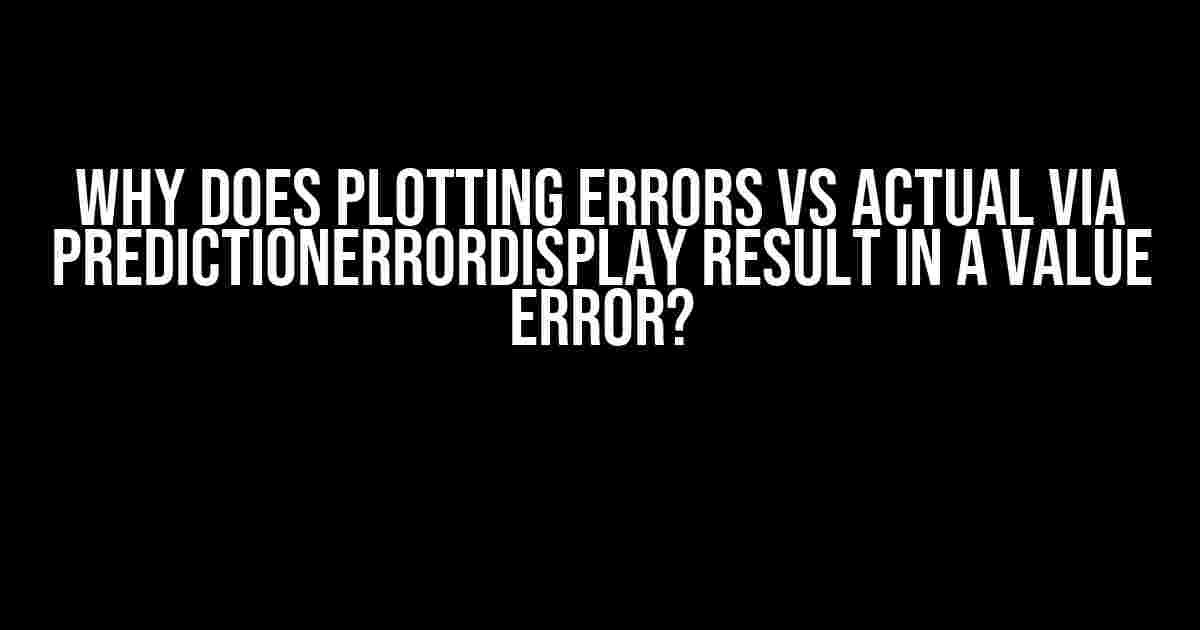Have you ever tried to visualize the errors of your machine learning model using the handy `PredictionErrorDisplay` tool, only to be met with a frustrating `ValueError`? You’re not alone! In this article, we’ll dive into the reasons behind this pesky error and provide you with a step-by-step guide to fix it.
What is PredictionErrorDisplay?
`PredictionErrorDisplay` is a fantastic tool from the `yale` library that helps you visualize the errors of your machine learning model. It takes in the actual values and predicted values of your model and plots them against each other, giving you a clear picture of how well your model is performing. Sounds simple, right?
But what’s going on with the ValueError?
So, why does plotting errors vs actual via `PredictionErrorDisplay` result in a `ValueError`? There are a few reasons for this:
- Incompatible data types: One of the most common reasons for the `ValueError` is that the data types of your actual and predicted values are incompatible.
- Missing or null values: If there are missing or null values in your data, `PredictionErrorDisplay` will throw a `ValueError`.
- Incorrect data structure: If your data is not structured correctly, `PredictionErrorDisplay` won’t be able to plot the errors correctly.
Fixing the ValueError
Okay, so now that we’ve identified the potential causes of the `ValueError`, let’s take a step-by-step approach to fixing it:
Step 1: Check data types
Make sure that your actual and predicted values are of the same data type. You can do this by using the `type()` function in Python:
print(type(actual_values))
print(type(predicted_values))If they’re not the same, you’ll need to convert one of them to match the other. For example, if your actual values are in a NumPy array and your predicted values are in a Pandas series, you can convert the series to a NumPy array using the `to_numpy()` method:
predicted_values = predicted_values.to_numpy()Step 2: Handle missing or null values
Next, let’s handle those pesky missing or null values. You can do this using the `dropna()` method from Pandas:
actual_values = actual_values.dropna()
predicted_values = predicted_values.dropna()This will remove any rows with missing or null values from your data.
Step 3: Check data structure
Now, let’s make sure that your data is structured correctly. `PredictionErrorDisplay` expects your data to be in a specific format, with the actual values in one column and the predicted values in another. You can use the `DataFrame` constructor from Pandas to create a new dataframe with the correct structure:
import pandas as pd
data = {'actual': actual_values, 'predicted': predicted_values}
df = pd.DataFrame(data)Putting it all together
Now that we’ve fixed the potential issues, let’s put it all together and plot those errors!
from yale.plot import PredictionErrorDisplay
PredictionErrorDisplay.from_estimator( estimator,
X=df,
y=df['actual'],
ax=ax)This code creates a `PredictionErrorDisplay` object from an estimator (your machine learning model), the feature data `X`, the actual values `y`, and an axis object `ax`. The `from_estimator` method takes care of the plotting for you.
Conclusion
And there you have it! By following these steps, you should be able to fix the `ValueError` and visualize the errors of your machine learning model using `PredictionErrorDisplay`. Remember to:
- Check that your data types are compatible
- Handle missing or null values
- Check that your data is structured correctly
By following these steps, you’ll be well on your way to creating informative and accurate error plots.
| Common causes of ValueError | Solutions |
|---|---|
| Incompatible data types | Use the `type()` function to check data types and convert if necessary |
| Missing or null values | Use the `dropna()` method to remove missing or null values |
| Incorrect data structure | Use the `DataFrame` constructor to create a new dataframe with the correct structure |
We hope this article has been helpful in resolving the `ValueError` issue when using `PredictionErrorDisplay`. Happy plotting!
Do you have any other questions about machine learning or data visualization? Let us know in the comments below!
Frequently Asked Question
Get answers to the most pressing question on every data scientist’s mind: why does plotting errors vs actual via PredictionErrorDisplay result in a value error?
Why does plotting errors vs actual via PredictionErrorDisplay result in a value error in the first place?
The PredictionErrorDisplay function expects the actual values and predicted values to have the same shape, but often they don’t, resulting in a value error. This mismatch can occur due to various reasons, such as differing index lengths or multivariate output.
What is the main difference between PredictionErrorDisplay and other plotting functions that don’t throw value errors?
PredictionErrorDisplay is more specific in its requirements compared to other plotting functions, requiring exact alignment between actual and predicted values. This specificity can lead to value errors if the inputs don’t meet the exact requirements.
How can I resolve the value error when using PredictionErrorDisplay?
To resolve the value error, ensure that the actual and predicted values have the same shape and index. You can achieve this by adjusting the indexing, reshaping the data, or using other plotting functions that are more flexible with input shapes.
Are there any alternative plotting functions that can replace PredictionErrorDisplay?
Yes, there are alternative plotting functions like plt.scatter or seaborn’s scatterplot that can achieve similar results without throwing value errors. These functions are more flexible with input shapes and can handle differing index lengths.
Can I customize PredictionErrorDisplay to work with my specific data structure?
Yes, you can customize PredictionErrorDisplay by preprocessing your data to match the function’s requirements. This might involve writing custom functions to reshape, align, or transform your data to ensure it meets the exact requirements of PredictionErrorDisplay.
